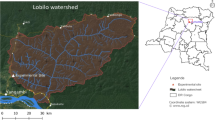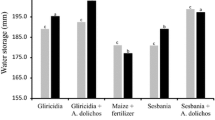Abstract
Leaves of multipurpose tree species (those providing more than one function or product of human use) can serve as sources of fertilizer for nutrient supply, especially nitrogen (N). In this study chopped leaves of tropical tree species (5 N-fixing species, 5 non-N-fixing species and combinations of 5 N-fixing with a non-N-fixing species) were incorporated in soil to evaluate its effects on wheat biological productivity (including grain yield, G YIELD) under dryland conditions. High quality leaves of N-fixing tree species (e.g. Dalbergia sissoo, Cassia fistula and Prosopis cineraria) had lower carbon/nitrogen (C/N), lignin/nitrogen (L IG/N), polyphenol/nitrogen (P PL/N) and lignin+polyphenol /nitrogen (L IG+P PL/N) ratios than low quality leaves of non-N-fixing species. Combination treatments had intermediate values of different parameters. Application of high quality leaves caused greater increases in wheat productivity and yield than other species. By the application of leaves of N-fixing trees, on average, wheat yield increased 160% relative to the control (no addition of leaves), and when combined with non-N-fixing Terminalia chebula leaves the yield increased 108%. Mean total net productivity (T NP) with N-fixing species treatments, exceeded mean T NP with non-N-fixing species and combination treatments by 50% and 28%, respectively. Multivariate regressions indicated that nitrogen (N) concentration in leaves (main nutrient), interacting with lignin (L IG) and polyphenol (P PL) concentrations, explained 79%–86% of variability in productivity parameters and yield. Strong correlation between L IG+PP L/N ratio of leaves with G YIELD of wheat crop suggests that the ratio can be used as a reliable index for mass screening of multipurpose tree species for use as soil amendments especially in dryland agriculture. Direct application of high quality N-fixing tree species leaves (especially D. sissoo, C fistula and P. cineraria), an uncommon practice in dry tropics in India, may serve as a short-term option for rapid enhancement of wheat productivity and soil fertility.
Similar content being viewed by others
References
Akkaya A, Dokuyucu T, Kara R, Dunilupinar Z. 2006. The effect of walnut and pine leaves on bread wheat growth and frequencies of common weed species in the East-Mediterranean region. Journal of Environmental Biology, 27(3): 523–527.
Anderson JM, Ingram JSI. 1993. Tropical Soil Biology and Fertility: A Handbook of Methods. Wallingford (UK): CAB International Publication, Oxford University Press, p. 221.
Anthofer J, Hanson J, Jutzi SC. 1998. Wheat growth as influenced by application of agroforestry tree prunings in Ethiopian highlands. Agroforestry Systems, 40: 1–18.
Byard R, Lewis KC, Montagini F. 1996. Leaf litter decomposition and mulch performance from mixed and monospecific plantations of native tree species in Costa Rica. Agriculture Ecosystems and Environment, 58: 145–155.
Chirwa PW, Black CR, Ong CK, Maghembe JA. 2003. Tree and crop productivity in gliricidia/maize/pigeonpea cropping system in Southern Malawi. Agroforestry Systems, 59: 265–277.
Costantinides M, Fownes JH. 1994. Nitrogen mineralization from leaves and litter of tropical plants: Relationship to nitrogen, lignin and soluble polyphenol concentrations. Soil Biology and Biochemistry, 26: 49–55.
Effland MJ. 1977. Modified procedure to determine acid insoluble lignin in wood and pulp. Technical Association of Pulp Industry (TAPPI), 60: 143–144.
Handayanto E, Cadisch G, Giller KE. 1994. Nitrogen release from prunings of legume hedgerow trees in relation to quality of the prunings and incubation method. Plant and Soil, 160: 237–248.
Haynes RJ. 1986. The decomposition process: mineralization, immobilization, humus formation, and degradation. In: R.J. Haynes (ed.), Mineral nitrogen in the plant-soil system. Orlando, Fl: Academic Press, pp. 52–109.
Jackson ML. 1973. Soil Chemical Analysis. Englewood, Cliffs (New Jersey): Prentice-Hall Inc Publisher. p. 498.
Kamara AY, Akobundu I.O, Sanginga N. Jutzi SC. 2000. Effect of mulch from selected multipurpose trees (MPTs) on growth, nitrogen nutrition and yield of maize (Zea mays L.). Journal of Agronomy and Crop Science, 184: 73–80.
Kundu S, Battacharya R, Prakesh V, Gupta HS, Pathak H, Ladha JK. 2007. Long-term yield trend and sustainability of rainfed soybean-wheat system through farmyard manure application in the sandy loam soil of Indian Himalayan. Biology and Fertility of Soils, 43: 271–280.
Lehman J, Sehroth G, Zech W. 1995. Decomposition and nutrient release from leaves, twigs and roots of three alley-cropped tree legumes in central Tago. Agroforestry Systems, 29(1): 21–36.
Mafongoya PL, Nair PKR, Dzowela BH. 1996. Multipurpose tree pruning as a source of nitrogen to maize under semi-arid conditions in Zimbabwe 3, Interactions of pruning quality and time and method of application on nitrogen recovery by maize in two soil types. Agroforestry Systems, 35: 57–70.
Myers RJK, Palm CA, Cuevas E, Gunatilleke IUN, Brossard M. 1994. The synchronization of nutrient mineralization and plant nutrient demand. In: P.L. Woomer and M.J. Swift (eds.), The biological management of tropical soil fertility. UK: Wiley-Sayce Publication, Oxford University Press, pp. 1–116.
McBrayer JF, Cromack K.Jr 1980. Effect of snow-pack on oak-litter breakdown and nutrient release in a Minnesota forest. Pedobiologia, 20: 47–54.
Mwiinga RD, Kwesiga FR, Kamara CS. 1994. Decomposition of leaves of six multipurpose tree species in Chipata, Zambia. Forest Ecology and Management, 64(2–3): 209–206.
Nyberg G, Ekblad A, Buresh R, Högberg P. 2002. Short-term patterns of carbon and nitrogen mineralization in a fallow field amended with green manures from agroforestry trees. Biology and Fertility of Soils, 36: 18–25.
Palm CA, Mayers RJK, Nandwa SM. 1997. Combined use of Organic and Inorganic nutrient Sources for Soil Fertility Maintenance and Replenishment. In: R.J. Buresh, P.A. Sanchez and F. Cathoun (eds), Replenishing soil fertility in Africa. SSSA special publication no. 51. Madison, Wis: Soil Science Society of America, American Society of Agronomy, pp. 193–217.
Sarrantonio M. 2003. Soil response to surface-applied residues of varying carbon-nitrogen ratios. Biology and Fertility of Soils, 37: 175–183.
Semwal RL, Maikhuri RK, Rao KS, Sen KK, Sexena KG. 2003. Leaf litter decomposition and nutrient release patterns of six multipurpose tree species of central Himalaya, India. Biomass and Bioenergy, 24: 3–11.
Silva GTA, Matos LV, Nobrega PO, Campello EFC, Resende AS. 2008. Chemical composition and decomposition rate of plants used as green manure. Scientia Agricola, 65(3): 298–305.
Srivastava R, Singh KP. 2002. Variations in soil organic C and N storage due to cultivation practices in the Gangetic plain, India. International Journal of Ecology and Environmental Sciences, 28: 193–199.
Tian G, Kang BT, Brusaard L. 1993. Mulching effects of plant residues with chemically contrasting compositions on maize growth and nutrient accumulation. Plant and Soil, 153: 179–187.
Tian G, Kang BT, Brussaard L. 1992. Effects of chemical composition of N, Ca, and Mg release during incubation of leaves from selected agroforestry and fallow plant species. Biogeochemistry, 16: 103–119.
Vinther FP, Hansen EM, Olesen JE. 2004. Effects of plant residues on crop performance, N mineralization and microbial activity including field CO2 and N2O fluxes in unfertilized crop rotations. Nutrient Cycling in Agroecosystems, 70: 189–199.
Author information
Authors and Affiliations
Corresponding author
Additional information
Fund project: This study was supported by Ministry of Environment and Forests, New Delhi, India.
Rights and permissions
About this article
Cite this article
Srivastava, R., Singh, K.P. Implications of multipurpose tree leaf application on wheat productivity in dry tropics. Journal of Forestry Research 24, 777–782 (2013). https://doi.org/10.1007/s11676-013-0416-z
Received:
Accepted:
Published:
Issue Date:
DOI: https://doi.org/10.1007/s11676-013-0416-z




